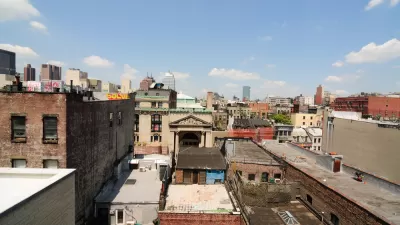Although Mayor Bill de Blasio's recent announcements provided some important details about his administration's affordable housing agenda, there are a few questions still left to be answered that will determine the success of the plan.
Greg David points to three numbers that—although not as compelling as the 200,000 total number of affordable units targeted by the plan—will determine how well the plan works in improving New York City's housing affordability troubles. The numbers are five (the total percentage increase in affordable housing units), seven (the targeted return on investment for housing developments), and eight (the total amount in billions of the city's planned in investment in affordable housing).
The problem with the five percent total growth in affordable housing, according to David: "So the plan may create affordable apartments for a group of New Yorkers, but it won't make the city more affordable as a whole because the housing supply won't increase enough to satisfy growing demand."
David goes on to detail the reasons the latter two figures mean that New Yorkers should temper their expectations about the overall impact of the plan.
FULL STORY: Mayor has a housing dilemma

Planetizen Federal Action Tracker
A weekly monitor of how Trump’s orders and actions are impacting planners and planning in America.

San Francisco's School District Spent $105M To Build Affordable Housing for Teachers — And That's Just the Beginning
SFUSD joins a growing list of school districts using their land holdings to address housing affordability challenges faced by their own employees.

The Tiny, Adorable $7,000 Car Turning Japan Onto EVs
The single seat Mibot charges from a regular plug as quickly as an iPad, and is about half the price of an average EV.

Seattle's Plan for Adopting Driverless Cars
Equity, safety, accessibility and affordability are front of mind as the city prepares for robotaxis and other autonomous vehicles.

As Trump Phases Out FEMA, Is It Time to Flee the Floodplains?
With less federal funding available for disaster relief efforts, the need to relocate at-risk communities is more urgent than ever.

With Protected Lanes, 460% More People Commute by Bike
For those needing more ammo, more data proving what we already knew is here.
Urban Design for Planners 1: Software Tools
This six-course series explores essential urban design concepts using open source software and equips planners with the tools they need to participate fully in the urban design process.
Planning for Universal Design
Learn the tools for implementing Universal Design in planning regulations.
Smith Gee Studio
City of Charlotte
City of Camden Redevelopment Agency
City of Astoria
Transportation Research & Education Center (TREC) at Portland State University
US High Speed Rail Association
City of Camden Redevelopment Agency
Municipality of Princeton (NJ)





























